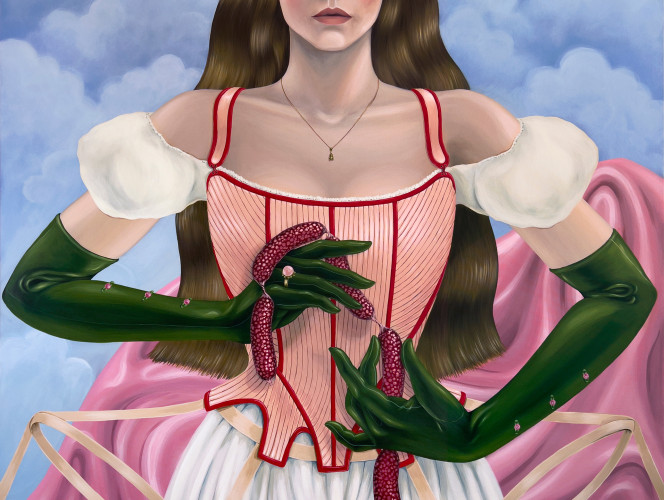
In the realm of theater, a spectacle is most dazzling when it revels in its artifice, manipulating its actors, costuming, and scenery into instruments for our delight and entertainment. In The Grumpy Girls, Jeanine Brito engages each of these mechanisms deftly, rigging scenes of a rich inner world. With all the smoke and mirrors of a dream, the artist enshrines herself and a conflict of identity on a sublimely grand stage.
These melodramatic scenes are saturated with a lush palette: large swathes of sumptuous blood red mingle with a noxious sage green—Victorian arsenic made docile—and muted pink and cream. The material nature of the canvases hints at the plasticity of the world they offer us: acrylic paint has been varnished and flattened to an artificial sheen, an unmoving porcelain mask. Brito’s inspirations for The Grumpy Girls were spectacular and exaggerated, among them the Technicolour theatrics of The Red Shoes (1948) and Tales of Hoffmann (1951). Their abstracted reality of theater and cinematic trickery is found in the backstage paintings, offering the viewer a perspective inaccessible to the imagined audience.
And of course, the costumes. Brito delights in fantasy and beribboned drama. Each figure wears a ballet costume in the same bilious green: for Some Vivid Dream (The Artist), an airy, classical tutu from 1870 to leave room for her wings; the figure in In Keeping With Tradition (The Girl) is cinched and bound in a romantic tutu from 1832 that pools around her like the vessels of blood; All The Comforts of Love (The Mother) depicts a fertility goddess in a Grecian-inspired 18th century silhouette, sleeve puffs as fleshy and round as her stomach. The girls are adorned with baby pink bows in varying degrees of fussiness, their feet restrained in satin pointe shoes (again, a nod to The Red Shoes). Opera length gloves—effectively latex fetishwear—enchant in both form and function, offering the girls a thin shield from their work at hand.
In Opening Night (The Grumpy Girls), a new figure joins the cast, a beached siren in stockings of the same slickness as her matching gloves. Brito renders the partial nudity of her figures in a highly stylized way, recalling Victorian glove etiquette: an offering of sensuality and vulnerability, but only to a controlled degree. Mourning relics of this same era were another source of inspiration for Brito. These keepsakes of teeth or locks of hair were material symbols of both memory and death—like handwriting or a fingerprint, each object authenticated a singular life. The artist uses hair as a personal curio, trimming her portal scenes and linking the figural paintings with braids. In tethering the girls together by hair as in Opening Night—one of the few bodily artifacts that remains after death—the artist reflects an impossible desire to preserve each of their individual identities, despite their ephemerality.
It is the denouement of the performance. Pale pink text, evocative of 1940s Technicolour and its artificial glory, sweeps the stage with the title of the show we’re all here for. The girls are indeed grumpy—petulant, even. They work wearily in service of the new central figure, caught between resistance and submission. The Mother appears stage left, poised to disrupt the scene with her scissors, snipping the hair that binds her to the others. Sacrifice rears its head once more as a theme in Brito’s work, who portrays this act as a necessary death to make way for a new identity.
In Libretto for The Grumpy Girls, the artist irreverently toys with our perception. We find items collected from the girls and the dreamlike portals, assembled together in a curio cabinet of sorts. Ornately braided hair is left static as a wig on a stand, bereft of any sentimentality. Presented on shelves, these objects we’ve come to imbue with significance are mere props, tools of a performance now shed by the artist. The snow white lamb is curled up, serene in a deep sleep; perhaps he, too, is resting before his next appearance. We are left to wonder if what we’ve witnessed was simply a cheeky trick, a deceptive wink to the audience, all for the sake of a good show. After all, that’s showbiz, baby.
—Elizabeth Polanco
Jeanine Brito (b. 1993, Germany) lives and works in Toronto, Canada. Her work explores themes of memory and desire, imagined in a theatrical, surrealist context. Self-taught, her previous experience as a graphic designer informs her approach to color and composition, where smooth, saturated surfaces meet photographic crops. Exhibitions include The Grumpy Girls, Nicodim, New York (2024, solo, forthcoming); The Invitation: A Fairytale by Jeanine Brito, Nicodim Upstairs, Los Angeles (2023, solo); DISEMBODIED, curated by Ben Lee Ritchie Handler, Nicodim, New York (2023); So Softly and Sweetly, La Causa Galeria, Madrid (2022, solo); You Me Me You, curated by Rachel Keller, Nicodim, Los Angeles (2022); and New Mythologies II, Huxley Parlour, London (2022).